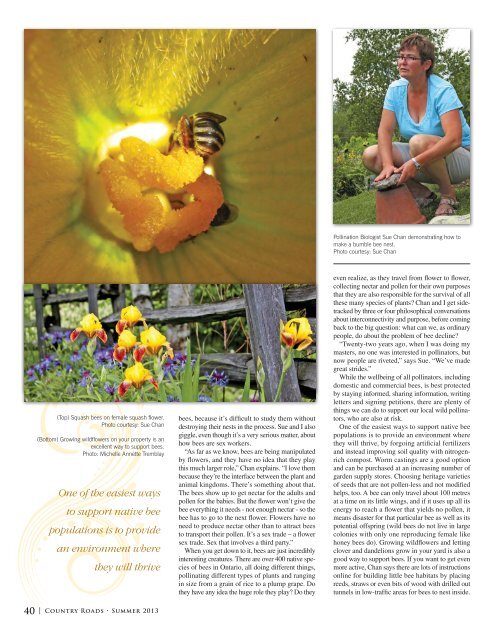Summer 2013 - Country Roads
Summer 2013 - Country Roads
Summer 2013 - Country Roads
Create successful ePaper yourself
Turn your PDF publications into a flip-book with our unique Google optimized e-Paper software.
Pollination Biologist Sue Chan demonstrating how tomake a bumble bee nest.Photo courtesy: Sue Chan(Top) Squash bees on female squash flower.Photo courtesy: Sue Chan(Bottom) Growing wildflowers on your property is anexcellent way to support bees.Photo: Michelle Annette TremblayOne of the easiest waysto support native beepopulations is to providean environment wherethey will thrive40 I <strong>Country</strong> <strong>Roads</strong> • <strong>Summer</strong> <strong>2013</strong>bees, because it’s difficult to study them withoutdestroying their nests in the process. Sue and I alsogiggle, even though it’s a very serious matter, abouthow bees are sex workers.“As far as we know, bees are being manipulatedby flowers, and they have no idea that they playthis much larger role,” Chan explains. “I love thembecause they’re the interface between the plant andanimal kingdoms. There’s something about that.The bees show up to get nectar for the adults andpollen for the babies. But the flower won’t give thebee everything it needs - not enough nectar - so thebee has to go to the next flower. Flowers have noneed to produce nectar other than to attract beesto transport their pollen. It’s a sex trade – a flowersex trade. Sex that involves a third party.”When you get down to it, bees are just incrediblyinteresting creatures. There are over 400 native speciesof bees in Ontario, all doing different things,pollinating different types of plants and rangingin size from a grain of rice to a plump grape. Dothey have any idea the huge role they play? Do theyeven realize, as they travel from flower to flower,collecting nectar and pollen for their own purposesthat they are also responsible for the survival of allthese many species of plants? Chan and I get sidetrackedby three or four philosophical conversationsabout interconnectivity and purpose, before comingback to the big question: what can we, as ordinarypeople, do about the problem of bee decline?“Twenty-two years ago, when I was doing mymasters, no one was interested in pollinators, butnow people are riveted,” says Sue. “We’ve madegreat strides.”While the wellbeing of all pollinators, includingdomestic and commercial bees, is best protectedby staying informed, sharing information, writingletters and signing petitions, there are plenty ofthings we can do to support our local wild pollinators,who are also at risk.One of the easiest ways to support native beepopulations is to provide an environment wherethey will thrive, by forgoing artificial fertilizersand instead improving soil quality with nitrogenrichcompost. Worm castings are a good optionand can be purchased at an increasing number ofgarden supply stores. Choosing heritage varietiesof seeds that are not pollen-less and not modifiedhelps, too. A bee can only travel about 100 metresat a time on its little wings, and if it uses up all itsenergy to reach a flower that yields no pollen, itmeans disaster for that particular bee as well as itspotential offspring (wild bees do not live in largecolonies with only one reproducing female likehoney bees do). Growing wildflowers and lettingclover and dandelions grow in your yard is also agood way to support bees. If you want to get evenmore active, Chan says there are lots of instructionsonline for building little bee habitats by placingreeds, straws or even bits of wood with drilled outtunnels in low-traffic areas for bees to nest inside.


